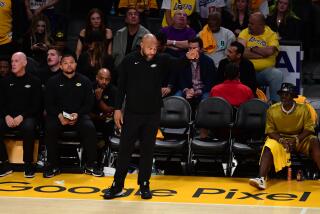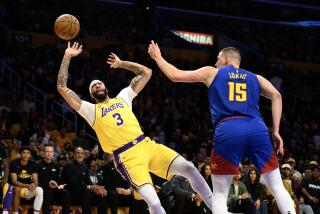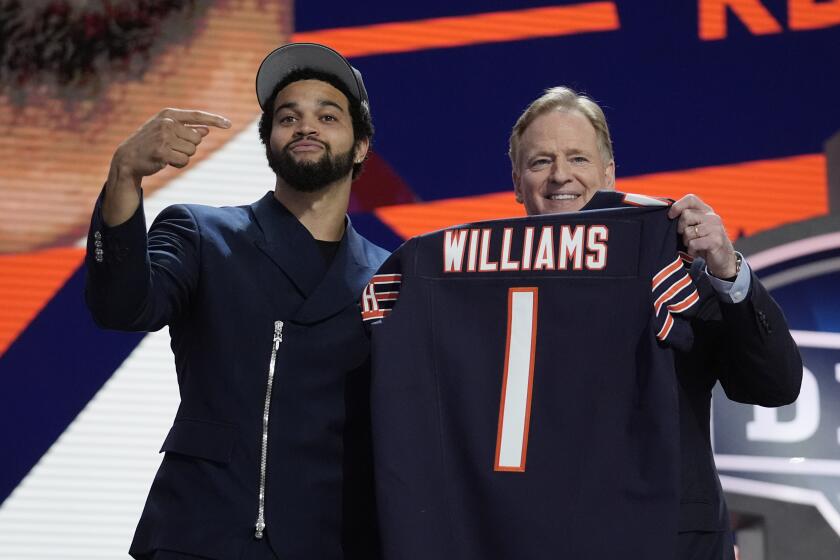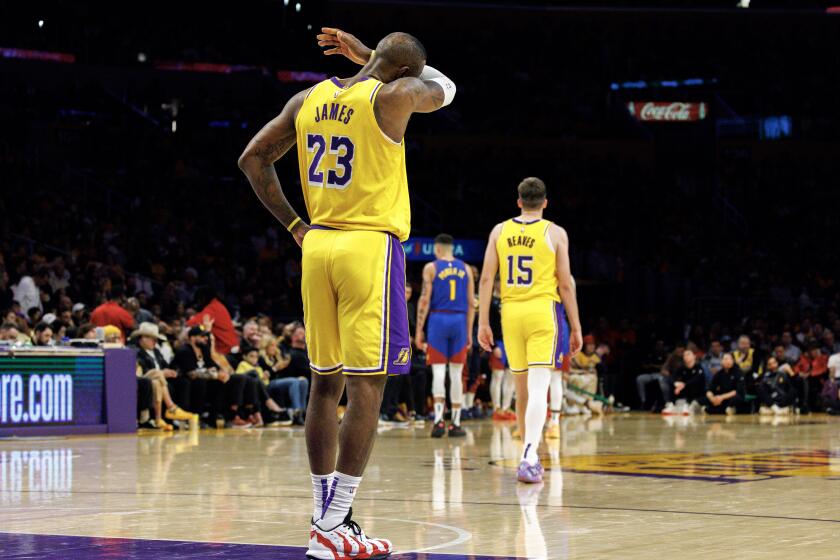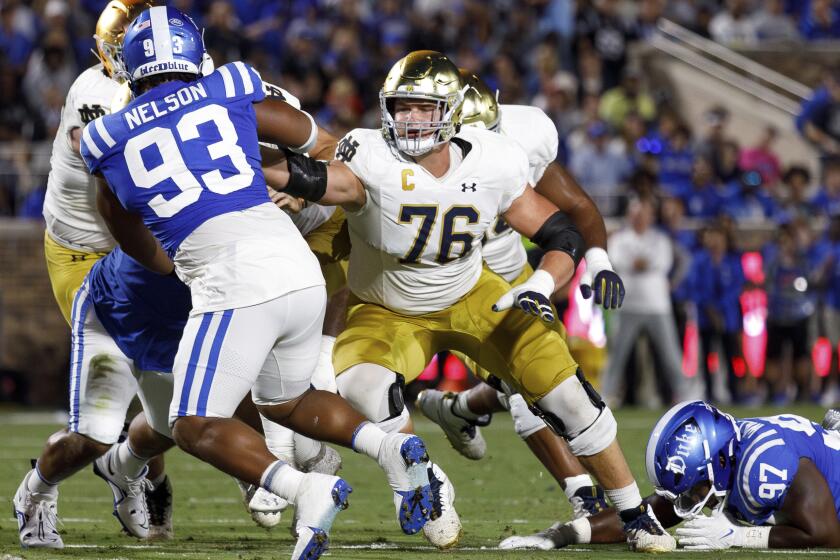Three-Pointers Fall Short of Final Two : Alford Scores 33 as Indiana Holds Off Banks and Las Vegas
Think about a Hoosier. A Hoosier may be the first part of a question (“Hoosier favorite team?”), a new television show set in Indiana (“Hoosier Boss?” starring Tony Danza) or it may be the name of the best basketball team in the nation this season.
A lot of people thought that Nevada Las Vegas, the best in the West, could extend its boundaries to include more territory, but that’s not the way it worked out Saturday at the Superdome before 64,959, the largest crowd to see a college basketball game.
The Hoosiers, the only college team still playing that has a hit movie named after it, upset the No. 1-ranked Runnin’ Rebels, 97-93, in a Final Four semifinal game that could have been worth the NCAA championship except for the fact that Indiana still has to play Syracuse.
So, Hoosier No. 1 team now?
“I guess we’ll be the favorite now,” Indiana center Dean Garrett said. “But we won’t talk about that much. You know, when you get to the Final Four, anybody can beat anybody.”
Here are the matchups that emerged Saturday. They’re both big: Indiana (29-4) of the Big Ten vs. Syracuse (31-6) of the Big East. Meanwhile, UNLV (37-2) of the Big Gripe fell by the wayside. That they’re not a part of the Final Two is no big upset, according to Rebel forward Jarvis Basnight, who said he felt as though the NCAA didn’t want them around anymore anyhow.
“They wanted Indiana or North Carolina to be in the championship game and that’s what they got,” Basnight said.
“If you touch (Steve) Alford or look at him wrong, it’s a problem. It’s been like that all year. We’re the outlaws.”
But Alford’s touch wasn’t bad, either. Alford scored 33 points in 37 minutes against the Rebels and, as usual, was behind Indiana’s second-half flurry that erased a UNLV lead and put the Hoosiers ahead to stay.
Never a hair out of place, never a jumper out of turn, Alford got some help from Garrett, Keith Smart and Rick Calloway to offset UNLV’s two-man stage show of Armon Gilliam and Freddie Banks.
Banks, who had 38 points, and Gilliam, who had 32, scored 70 of the Rebels’ 93 points. No one else was in double figures for UNLV, which nevertheless had a chance to win in the last minute.
As the 10th and last three-pointer of the game by Banks got UNLV to within 92-88 with 1:13 remaining, and right after Indiana’s Steve Eyl missed the front end of a one-and-one, the Rebels were still in it.
In a matter of seconds, they were out of it. Banks made 10 of 19 from behind the three-point line, but he suddenly began scatter-shooting. He missed, which was unusual, Gerald Paddio missed, which was typical, and Banks missed again on a short follow shot.
Gilliam rejected Garrett, but Banks missed a three-pointer and then a free throw with 28 seconds remaining. Two free throws by Alford, who had missed twice on a two-shot foul earlier, sank two this time.
Then, after Mark Wade shanked a three-pointer, Eyl got loose for a breakaway layup, which turned out to be a three-point play. It also turned out to be the ballgame, 97-88, with 13 seconds left.
For Indiana, it was just the kind of game it was looking for. Coach Bob Knight, given five days to prepare for UNLV, came up with something that worked. It all seemed so simple.
To beat the Rebels’ full-court pressure, he let a big man, usually either Eyl or Calloway, bring the ball up court. He sagged off Wade and smothered Gilliam. Although Gilliam still got his points, Wade did not make a shot until there were eight seconds left.
With Indiana extending its defense to snag UNLV’s three-point shooters, only Banks could compensate. In defeat, Banks found something nice to talk about.
“My shooting was tremendous,” he said.
And that was about the extent of the Rebels’ game, besides Gilliam. Wade got caught in a hectic Hoosier defense of switches and pressure, which eventually took its toll on him. “It was like trying to get through an offensive line,” he said.
What went wrong?
“We went wrong anywhere,” Wade said.
What went right for the Hoosiers was a much different story. Indiana led, 53-47, at halftime, even though the Hoosiers had fallen behind quickly, 14-9, on consecutive three-pointers by Paddio, who finished with a 2-for-13 afternoon, and then Banks.
But then Indiana went on a 16-4 run to take a 25-18 lead. This was one of the stretches of the game Knight later identified as critical.
“That period in the game gave us the opportunity to withstand anything that they would do later in the game,” Knight said.
Eyl played 20 minutes in relief of starting forward Daryl Thomas, who picked up three fouls in the first three minutes. But while Knight got help from both Eyl and guard Joe Hillman, Tarkanian received very little from his bench, especially Gary Graham, who had 1 point, 0 assists and 4 fouls in 25 minutes.
“Our scoring basically has come from three positions all year, and today our scoring came from two positions,” Tarkanian said.
Those two positions were occupied by Banks and Gilliam. Together, they scored 14 of UNLV’s 16 points to start the second half, eight by Gilliam, who impressed Knight.
When Gilliam, who was often triple-teamed, dumped in a short power jumper, the Rebels led, 63-61. Then Indiana scored on its next five possessions, three times on baseline jumpers by Alford, and the Hoosiers were back on top to stay, 71-65, with 11:03 to go.
There was only one Rebel charge left and it didn’t get far enough, which is how Alford has envisioned it all along.
“We just didn’t want them to have run after run after run,” he said.
Yet Indiana was running, too, and the Hoosiers can play that kind of game now that they are playing Smart, a junior college transfer at point guard. Before fouling out, Smart had 14 points, which went along nicely with Garrett’s 18 points and 11 rebounds and 12 points by Calloway.
“We didn’t think that it would be the kind of game we could play with all kinds of patience and a lot of passing and dribbling because we thought that their defensive pressure was too great,” Knight said of the Hoosiers’ quick-paced tempo.
“We felt that if it was going to be a 90 (-point game), it would be played at 90 rather than 60. We felt that if we tried to play a game at 60, then they might score 85.”
Knight was right. If he can be right again Monday night, “Hoosier best team in the country” won’t be a question, it will be a fact.
More to Read
Get our high school sports newsletter
Prep Rally is devoted to the SoCal high school sports experience, bringing you scores, stories and a behind-the-scenes look at what makes prep sports so popular.
You may occasionally receive promotional content from the Los Angeles Times.
